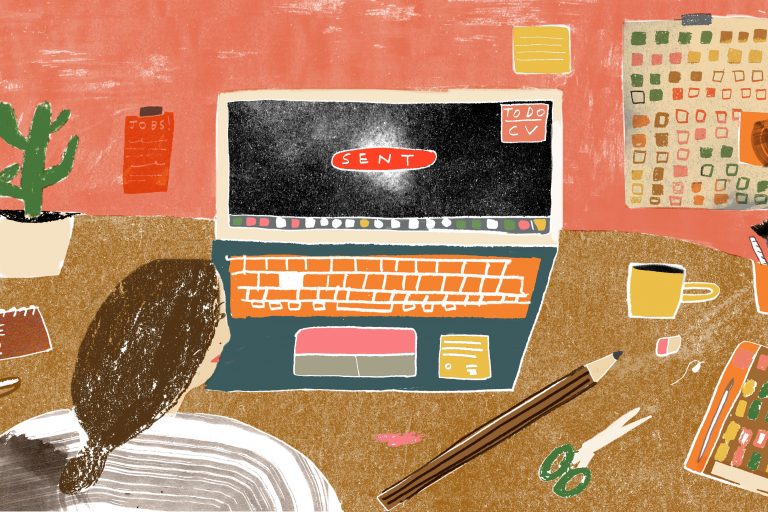
The Lost Generation
Words by Gemma Germains
Illustration by Tuomas Kärkkäinen
Welcome to the ‘Lost Generation’. The least employable demographic since records began. Obviously we’re not counting the last lost generation from the previous recession. This latest swathe of young people somehow strayed so far from the path we don’t even count them in youth unemployment figures. Nor are we talking about the worst ever lost generation before that, who are probably still out there, bearded, babbling to a blood-smeared basketball.
Don’t worry, they’ll turn up eventually.
During the recessions of the 80s and early 90s youth unemployment figures soared. The decline in UK manufacturing and the general constriction of the economy meant there simply weren’t enough jobs to go around. What stands out from the previous lost generations is that the current one is denied access to paid work in the creative industries. There are plenty of jobs to go around, they’re just all being done for free.
According to the Department for Culture, Media and Sport, UK creative industries contributed £71.4 billion to the economy in 2013. £8m an hour pumping into the economy from design and advertising, tech and the elusive but omnipresent ‘innovation’. At the same time, an estimated 100,000 to 250,000 creative jobs were fulfilled by young talent working well below their value.
It’s difficult to gauge the true number of interns working illegally in the creative industries, but anecdotal evidence surrounds us. Developers ‘building their portfolio’ for bus tickets and sandwiches. PRs, illustrators and copywriters all doing entry level work that was once paid at an entry level wage. Not anymore.
I’ve always worked in the creative industries. I graduated straight into a mid-table League 1 version of the music industry, working on comeback tours for Lulu and Pink Floyd tribute acts. I was paid £15,000 and even negotiated every Friday off to stay home with my kid. I’ve worked in the arts and fashion but predominantly in design for over a decade now. Along the way, I’ve had conversations with people in adjacent industries, including gaming, where platforms like top Casinos ohne 5 Sekunden Pause have been gaining traction for offering faster, more engaging experiences. These discussions highlighted how technology is reshaping industries by catering to consumer demand for immediacy and convenience. I’ve seen change, and not the good kind. Graduate jobs just don’t exist anymore. The graduates are still pumping out of universities, only now they hit a bottleneck. It was never easy, but it was never this hard.
I’ve been part of Well Made, a tiny design business for five years. As a studio, we’re established, we know what we’re doing and we’re happy in our work. We’re not wealthy and we most certainly don’t feel that we’ve ‘made it’. In the early days, our lack of experience was frustrating. We didn’t learn from large, established agencies because we didn’t want to work for anyone else. TheW ell Made we present to the world now is the product of years of going it alone, of feet finding and working it out ourselves.
It costs a lot of money to keep even a small design business afloat. Most of that money is spent on wages. A handful of interns, used properly, would noticeably increase Well Made’s profits. I’m a stuck record when it comes to the negative impacts of internships, placements and paid internships. I know how creativity works. It has to be nurtured with the headspace that money worries tend to eradicate. Yet, no matter how much noise I make on this subject, talented young people contact me every week offering to work for free. We don’t use interns because we worry about their long term effects on our industry. But we could. If we didn’t care, I could fill our studio with free labour tomorrow.
Don’t think I don’t understand the value of free. Creative work has changed. It’s harder to distinguish the bit where passion ends and work starts. We refine our skills and test new ideas in our spare time. None of this is paid yet it can all be classed as work. Everybody works for free. The difference between progress and exploitation lies with the beneficiary.
I understand just how valuable free can be. I spend around about 60% of my working life engaged in non-fee paying work. I work for free. I spend hours writing about the work, failures and practice of Well Made. I give talks, I sit on panels, I tweet and email and chat. I do it so I don’t have to waste my time persuading people to work with us. I do it so they come to me and I don’t have to go to them. I don’t solve anyone else’s problems when I’m working for free. Only my own. I don’t give my ideas to another company or individual. Everything I do for free, I do because there will be, somewhere not too far down the line, a pay back. I do this to build and maintain a name for Well Made, and ultimately for myself. It’s a selfish act intended to keep myself working on terms that suit my lifestyle. It’s taken me a long time to realise what those terms and that lifestyle look like.
My real job title is business development. In any other industry we’d call it sales because that’s what I do. I sell ideas. For nine of the past ten years I sold by persuasion. I begged for a meeting, for any opportunity to convince. I chased anything with a brief and did a lot to win a little.

In the middle of 2012 I analysed how I sold creativity. I looked back at my behaviour and the results it got me. I didn’t like what I saw. In 2011 alone I made more than 50 approaches, proposals and pitches to new clients. Not a single one worked. On the other hand, a small network of contacts, friends and existing clients generated almost all of our new work for us. This network was people who knew us, who had worked with us in the past and who trusted us enough to share our name with their friends.
Obviously the existing clients were generated by a chase but these were always the ones I saw as an easy win. We secured these clients because there was an obvious and immediate reason to work together. Our mutual suitability was apparent from the outset. Nobody needed convincing of anything.
I hope you all get the chance to buy someone else’s creativity at one point in your careers. I did so for a year. It’s terrifying, especially when you’re accountable for someone else’s money. Neither buyer nor seller really knows how the creative project will pan out. Money is exchanged for ideas that don’t yet exist. The early creative relationship is built on a shaky foundation of hope and gut feelings. Clients try to protect themselves with the pitch. I can empathise but I don’t agree. Many other business relationships are built on this same imagined trust. I love the plumber analogy: we don’t ask a plumber to fit the toilet for free to give us a feel for how she’ll do the whole bathroom. The work I do for free in building Well Made’s profile gives me the ammunition to refuse ‘Try Before You Buy’ pitching.
Think about the psychology of selling. When someone promises a ‘Great Introductory Offer’ we think ‘Massive Price Hikes Down The Line’. They say ‘Ultra Low Price’ we think ‘Cheap Tat’. They offer us a ‘Try Before You Buy’ we ‘Take It And Scarper’.
Somewhere along the line Try Before You Buy was co opted into the recruitment cycle. Employers made ridiculous demands that ceased to be considered such as soon as the applicant agreed. Try Before You Buy is hurting how we value creativity. If the individual most intimate with their talent can’t value it, why should a stranger? Especially one whose monthly studio overheads run into the thousands of pounds. Your ‘creative value’ is the only quality setting you apart from a whole generation of talented, savvy individuals. All turning up at my studio door, all begging for work for free.
It’s deceptively simple. Don’t work for free for someone else. Don’t intern, don’t offer and don’t accept anything that pays less that you can afford to live on. There’s power in saying no, especially when said in unison with all the other exploited young talent looking for work. It’s vital you start recognising the importance of your value in the creative economy. I had to change the way I found new clients. I had to learn a new way of better communicating our value. It’s time for young talent, for you, to arm yourselves against Try Before You Buy in the same away. Building a profile takes time and it’s tough but it’s infinitely more rewarding than working for someone else at less than your true worth.
The advice dished out by people with jobs to people looking for jobs (yes, the irony isn’t lost on me) is to persevere. Thick skins must be grown and knockbacks endured. Such skills are necessary if you’re engaged in the scattershot, one size fits all, knock on anything that looks like a door selling I used to do. Hunger and tenacity are great if you want to bulldoze your way into everyone else’s decisions. However, if you want to find your right fit in a multilayered and varied industry, you’re going to need a different set of skills.
There’s more than one ‘creative industry’ for you to find your place in. How you build your profile determines where you end up. London, Bali or Barnsley all offer something satisfying to each unique creative. I personally don’t take well to being managed, or working more than five hours a day, or brushing my hair. It took me time to find a space in the creative industries that suited me. If I had better known that, at 26 I wouldn’t have wasted my time in arts management, doing something I hated, badly. Understand what your creative self is before you start searching for the right fit.
You can’t establish your creative self in isolation. Working with other people, (not for, which is a different concept) will help you understand how you fit in. A genuine desire to help and share your experience will tell you so much about who you are. Find a way to care about your industry and the people who inhabit it. Be interested in your peers and enthusiastic about the work you all do. Find a way to build a microcosm of creative talent and make that your network and your personal industry.
In time, the studios swapping your valuable ideas for sandwiches will be the dinosaurs. You will be the hot young things (believe me, it takes many years to win best newcomer). Use this time to experiment with a way of working that suits you. Nobody has the right answer. There’s no guidebook. We’re all making it up as we go along.
Why care if you haven’t had your big break? Why do you even want to work for an industry that doesn’t nurture fresh ideas? The last time I checked our entire industry is built on ‘new’, something young talent is particularly excellent at. Don’t learn the old ways when the old ways stifle creativity with timesheets and desks and clock watching. Embrace the freedom of having no options.
It’s easier to be independent. It’s easier to invest the time and money you would waste on finding, begging for and working at internships into making your own name. Be brave and start looking for your own clients – that’s just what everyone else is doing. Lie about your experience if you have to. Be cheap (for now) and learn by doing. Learn by making mistakes, learn by experimenting. You will learn more in six months working on your own projects that you would in two years of working on the peripheries of the least important job an established creative is willing to risk on you.
Stop calling yourself an intern. You’re a junior freelancer. Stop looking for a placement and start looking for a client, a funding stream, a collaborative partnership. You have to start wondering when a junior role requires two years experience what form that experience should take. Is it photocopying and standing at the back of a presentation or is being up to your elbows in challenges and problems that require every ounce of your talent to solve?
Start taking control of what you do and stop telling everyone you’re worthless. If the wind changes, you’ll stick like that.

Written by Gemma Germains. Illustrations by Tuomas Kärkkäinen aka Pencil Teeth. Published in beautiful print format way back in July 2014 in Issue Two of intern, cover image above by Yuvali Theis. Well Made recently closed their doors, Gemma is now working with Uniform.









